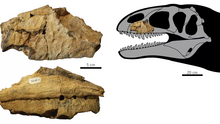Ulughbegsaurus
| Ulughbegsaurus Temporal range:
| |
|---|---|

| |
| Holotype specimen | |
| Scientific classification | |
| Kingdom: | Animalia |
| Phylum: | Chordata |
| Clade: | Dinosauria |
| Clade: | Saurischia |
| Clade: | Theropoda |
| Clade: | †Carcharodontosauria |
| Genus: | †Ulughbegsaurus Tanaka et al., 2021 |
| Type species | |
| †Ulughbegsaurus uzbekistanensis Tanaka et al., 2021
| |
Ulughbegsaurus (meaning "Ulugh Beg's reptile") is a genus of carcharodontosaurian theropod dinosaur from the Late Cretaceous aged Bissekty Formation, Uzbekistan.[1] The type species is Ulughbegsaurus uzbekistanensis.[2]
Discovery and naming[]
Ulughbegsaurus was initially discovered within the Bissekty Formation, Uzbekistan in the 1980s based on the holotype UzSGM 11-01-02, consisting of a partial left maxilla. The holotype despite its significance would remain in the collection of the State Geological Museum of the State Committee of the Republic of Uzbekistan on Geology and Mineral Resources, Tashkent, Uzbekistan until 2019 when it was rediscovered. Two additional referred specimens have been attributed to the genus including CCMGE 600/12457, an jugal ramus of a left maxilla that was previously referred to the dromaeosaurid Itemirus and ZIN PH 357/16, the posterior end of a right maxilla.
Isolated teeth from the Bissekty Formation show similarities with carcharodontosaurian morphology, suggesting they may belong to Ulughbegsaurus or possibly another genus of carcharodontosaurian.
The genus and species was later named in 2021 by Tanaka et al., honouring the 15th century Timurid sultan and scientist Ulugh Beg and the country of its discovery.
Description[]
The body length of Ulughbegsaurus is estimated at 7.5–8 metres (25–26 ft) and its weight at over 1,000 kilograms (2,200 lb).[2]
Classification[]
Tanaka et al. ran two phylogenetic analyses using two different datasets to determine the relationships of Ulughbegsaurus. The first placed it in a polytomy including Neovenator and other megaraptorans, while the second placed it in a polytomy including other basal carcharodontosaurians; megaraptorans were instead recovered as members of the Tyrannosauroidea.
Both analyses are shown below:[2]
|
Topology 1: Hendrickx & Mateus dataset
|
Topology 2: Chokchaloemwong et al. dataset
|
Paleobiology[]
Ulughbegsaurus coexisted in the Bissekty Formation environment alongside other carnivorous theropods, including the tyrannosauroid Timurlengia and the dromaeosaurid Itemirus. Due to its size, it may have been the apex predator of the environment; this shows that carcharodontosaurids were still the dominant carnivorous theropods (instead of the tyrannosauroids) as late as the Turonian, at least in Asia.[2][3]
References[]
- ^ Rieger, Sarah (7 September 2021). "Newly discovered dinosaur predated tyrannosaurs — and at the time was a bigger apex predator". CBC News. Retrieved 8 September 2021.
{{cite web}}: CS1 maint: url-status (link) - ^ a b c d Tanaka K, Anvarov OU, Zelenitsky DK, Ahmedshaev AS, Kobayashi Y (2021). "A new carcharodontosaurian theropod dinosaur occupies apex predator niche in the early Late Cretaceous of Uzbekistan". Royal Society Open Science. 8 (9): Article ID 210923. Bibcode:2021RSOS....810923T. doi:10.1098/rsos.210923. PMC 8424376. PMID 34527277.
- ^ Black, Riley. "New, Giant Carnivorous Dinosaur Was a Terror to Smaller Tyrannosaurs". Smithsonian Magazine. Retrieved 2021-09-08.
- Bissekty Formation
- Carcharodontosauria
- Turonian life
- Late Cretaceous dinosaurs of Asia
- Fossil taxa described in 2021
- Theropod stubs













